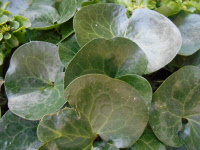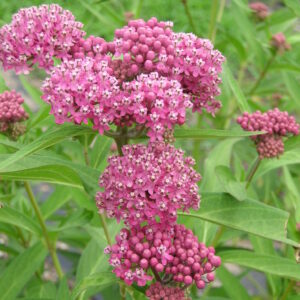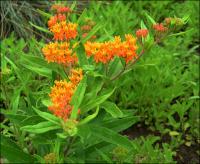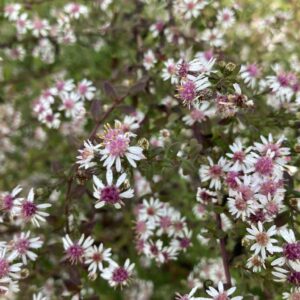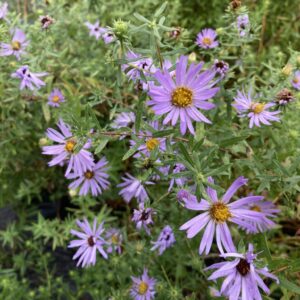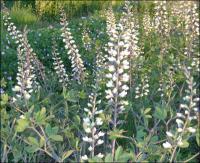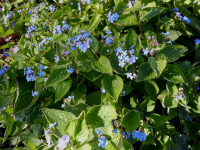Deer Resistant Plants
Showing 25–32 of 163 results
-
Asarum europaeum syn. Hexastylis europaeum European snakeroot, Wild ginger Z 4-9
Glossy, polished, round leaves with purplish, sepia-toned bell-like flowers hidden by leaves.
OUT OF STOCK – EMAIL FOR AVAILABILITY
Glossy, polished, round leaves with purplish, sepia-toned bell-like flowers hidden by leaves.
Size: 4-6” x 12” slow spreader
Care: shade to part shade in moist to moist well-drained acidic soil
Native: Europe
Awards: Elisabeth Carey Miller Garden Great Plant Pick & England’s Royal Horticultural Society Award of Merit.Identified by Dioscordies in De Materica Medica for medicinal use around 70 A.D. According to Dioscorides in Roman times this plant cured ailments of the eyes, ears, stomach, mind, and the head. Grown in the Eichstätt Garden, the garden of Johann Konrad von Gemmingen, prince bishop of Eichstätt in Bavaria, c. 1600. Gerard (1633) reported that this Wild ginger prevented increase of hard swelling cankers by topical application. Powdered root mixed with wine cured sciatica, gout, dropsy, and ague. The name Asarum comes from Greek phrase “to adorn” meaning it needs adornment.
-
Asclepias incarnata Swamp milkweed Z 3-9
Fragrant medium pink umbels, like an upside down ballerina’s skirt, July – September. One of internationally known garden designer Piet Oudolf’s 100 “MUST HAVE” plants, Gardens Illustrated 94 (2013)
Fragrant medium pink umbels, like an upside down ballerina’s skirt, July – September. One of internationally known garden designer Piet Oudolf’s 100 “MUST HAVE” plants, Gardens Illustrated 94 (2013)
Size: 3’-4’ x 2-3’
Care: Sun in moist to moist well-drained soil
Native: North America – all states except those along the Pacific Coast – Wisconsin native.
Wildlife Value: host for Monarch caterpillars, flowers are source of nectar for several butterfliesNamed after Asclepias, a Greek god of medicine. Native American groups used Swamp milkweed – Chippewa to increase their strength & the stems made into twine; Iroquois to heal navels in babies, to increase or decrease urine and to make a person strong enough to punish witches; Meskwaki to drive out tapeworms; and Menominee used it as an ingredient in food – added to deer soup & cornmeal mush. Oneida used the root to remedy asthma and whooping cough. They made thread to sew moccasins with the stems. Lakota Sioux: “The pulverized root is made into a salve which is used to treat swollen glands. The young seed pods are edible after cooking. An infusion of the roots is used to treat asthma, rheumatism, syphilis, and a weak heart.” Listed as growing in England in Philip Miller’s Gardeners’ Dictionary, 1768. Grown at America’s 1st botanic garden, Elgin Botanic Garden 1811. Pressed specimen in Emily Dickinson’s herbarium. “The downy parachutes . . . attached to each seed are six times more buoyant than cork and five times warmer than wool. Large quantities of milkweed were grown for use as stuffing in pillows and lifejackets during World War II.” USDA Natural Resources Conservation Service.
-
Asclepias tuberosa Butterfly weed, Pleurisy-root Z 4-9
Gorgeous - July - September bright orange cymes
OUT OF STOCK
Gorgeous – July – September bright orange cymes
Size: 2-3' x 12"
Care: Sun in well-drained to moist well-drained soil
Native: East and south North America, Wisconsin native
Wildlife Value: Host for Monarch caterpillars and its nectar is a favorite for 13 different butterflies: 4 Swallowtails, 2 Fritillaries, Checkered white, Spring azure, Small copper, Sachem, Monarch, and Coral and Gray hairstreaks. Attracts Ladybugs that eat many insect pests.
Awards: Great Plants for Great Plains; Perennial Plant Assn. Plant of the Year 2017.Named after Asclepias, a Greek god of medicine. Omaha Indians ate the raw root to cure bronchial and pulmonary ailments, their Shell Society was the authorized guardian of the plant, taking 4 days to dig, prepare and distribute the root. Most important medicine for Menominee Indians. The Iroquois smashed roots on legs to impart strength to runners. Navajo cured coyote bites and flu with Butterfly weed. HoChunk placed masticated root into wounds. Collected and sent to England by Rev. John Banister in colonial Virginia c. 1680. Cultivated by Jefferson. Pressed specimen in Emily Dickinson’s herbarium.
-
Aster laterifolius ‘Horizontalis’ syn Symphyotrichum laterifolius ‘Horizontalis’ Horizontal Calico Aster Z 4-8
Unique horizontally branching aster covered in small pink and white daisy-like flowers with dark pink centers blooming in late summer-fall. Foliage turns copper/purple in fall.
OUT OF STOCK
Unique horizontally branching aster covered in small pink and white daisy-like flowers with dark pink centers blooming in late summer-fall. Foliage turns copper/purple in fall.
Size: 24” x 24”
Care: full sun to part shade in well-drained soil
Native: Eastern and Central North America
Wildlife Value: attracts bees and butterflies. Deer resistant, Black walnut resistant.
Awards: RHS Award of Garden MeritFirst described by French botanist René Desfontaines (1750-1802). Harvard botanist Asa Gray named the variety in 1895.
-
Aster oblongifolius syn. Symphyotrichum oblongifolium, Aromatic aster Z 3-8
Purplish blue daisies with yellow centers blooming in September to November, Good, bushy mound shape. Called “aromatic” for the fragrance of its leaves.
Purplish blue daisies with yellow centers blooming in September to November, Good, bushy mound shape. Called “aromatic” for the fragrance of its leaves.
Size: 1-2’ x 1-3’
Care: sun to shade in well-drained to moist well-drained soil
Native: Pennsylvania to No. Carolina west to Wyoming & Texas, Wisconsin native
Wildlife Value: Bees collect pollen and nectar from it. Medium sized butterflies collect its nectar. Its leaves support Silvery checkerspot and some moth caterpillars, Deer resistant.
Size: Navajo made a decoction of this to protect against witches.Aster means star, referring to the flower’s form. Navajo made a decoction of this to protect against witches.
Meriwether Lewis collected this on the Expedition September 21, 1804, the day after nearly being swept away while Lewis and the Corps of discovery slept on an eroding sandbar, near the Big Bend of the Missouri River in South Dakota. 1st published description by planthunter Thomas Nuttall (1786-1879) in 1818..
-
Baptisia australis syn. Saphora australis False Indigo Z 3-9
Foot-long spires of indigo blue pea-like flowers (it’s a legume) in June followed by ornamental black seed pods on this perennial that looks like a shrub. Internationally known garden designer Piet Oudolf’s 100 “MUST HAVE” plants, Gardens Illustrated 94 (2013).
Foot-long spires of indigo blue pea-like flowers (it’s a legume) in June followed by ornamental black seed pods on this perennial that looks like a shrub. Internationally known garden designer Piet Oudolf’s 100 “MUST HAVE” plants, Gardens Illustrated 94 (2013).
Size: 3' x 3'
Care: Full sun in well-drained soil. Heat and drought tolerant.
Native: Eastern United States, Wisconsin native.
Wildlife Value: Food source for several caterpillars and nectar for a number of butterflies. Deer resistant.
Awards: Received England’s Royal Horticultural Society Award of Merit. Perennial Plant Association Plant of the Year Award, 2010. Missouri Botanic Garden Plant of MeritBaptisia is Greek meaning to dye referring to use of the plant as a substitute for indigo dye. Cherokee used Baptisia australis for a number of illnesses: cease mortification, cure toothaches. Collected by John Bartram (1699-1777) plant explorer and colonial nurseryman by 1748.
-
Baptisia leucantha syn. Baptisia lacteata, Baptisia alba White Wild Indigo, Prairie wild indigo Z 3-9
Towering creamy white flower spikes in May & June followed by dark seed pods.
Towering creamy white flower spikes in May & June followed by dark seed pods.
Size: 3-5' x 2-3'
Care: full sun to part shade in rich well-drained soil.
Native: Wisconsin native – from Minnesota to Texas.
Wildlife Value: food source for several caterpillars and nectar and pollen for a number of butterflies and bees. Deer resistant.Winnebago (HoChunk) mashed cooked root to make a poultice applied to remedy inflammation of the womb. Baptisia is Greek meaning to dye referring to use of Baptisia australis as a substitute for indigo dye. Leucantha means white flowered.
-
Brunnera macrophyllum syn. Anchusa myosotidiflora syn. Myosotis macrophylla Siberian bugloss Z 3-7
Panicles of robin’s egg blue forget-me-not- type flowers in May and June, contrasts with its bold, heart-shaped foliage. One of the best spring flowers.
Panicles of robin’s egg blue forget-me-not- type flowers in May and June, contrasts with its bold, heart-shaped foliage. One of the best spring flowers.
Size: 12" x 12"
Care: part shade to shade in moist to moist well-drained soil
Native: Caucasus & Siberia
Wildlife Value: deer resistant
Awards: Royal Horticultural Society Award of Garden MeritNamed for Swiss botanist Samuel Brunner (1790-1844). Collected by Russian botanist Johann Friedrich Adam (1780-1838) in Siberia c. 1806.

